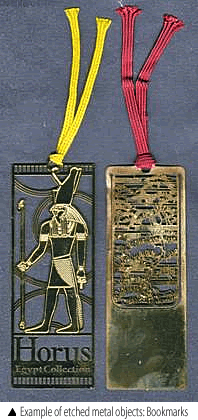The word "metal etching" in general may often be associated with metallurgical examinations of alloys where prepared test specimen are chemically or electro-chemically corroded (etched). But this type of etching is only for observations and measurements. Similarly, "etching" of heat treated/machined parts to remove scales and altered layers with various pickling acids, as well as acid/alkaline corrosion embossing have been customarily used, but they are for surface preparations prior to other surface treatment processes.
| The "etching" processes we are about to cover in this section are, for instance: copper etching for printed circuit boards where traces are created by dissolving only the prescribed sections of the copper on copper lined plastic substrates; etching of copper alloys and stainless steel alloys to create indelible characters and patterns by corrosion engraving for name plates and printing plates; and etching process used to create patterned holes on thin metal plates. In other words, the "etching" in discussion here is equivalent to machining of parts, and therefore often called "Chemical Milling". The word "etching" is interpreted as "corrosion" in Japanese language, but technical literature defines it as "Etching is a process of chemically removing materials from substrates according to given matching patterns". There are two types, the deep etching and superficial (surface) etching, of etching processes. The former type of etching is used for forming outlines and creating holes. The latter type removes very little material where the etching agent only roughen the surfaces, and typically used for name plates and the like. This section will cover the former type "Deep etching". There are two types of etching processes: chemical etching; and electrolytic etching. The chemical etching uses chemical-resist patterns drawn on metal substrates where the exposed metal is removed by the etchant. The electrolytic etching electrochemically removes materials by using electrodes formed into intended shapes as cathodes and the object itself as an anode. Electrolyte fills the space between the two and electrolysis using a direct current removes the intended material. |  |
![[Fig.1] Hydrogen embrittlement measurement probe conceptual diagram [Fig.1] Hydrogen embrittlement measurement probe conceptual diagram](http://www.misumi-techcentral.com/tt/en/surface/images/015.gif)
![[Fig.1] View of C Ring [Fig.1] View of C Ring](http://www.misumi-techcentral.com/tt/en/surface/images/014_01.gif)
